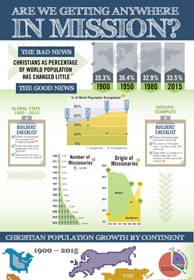Are We Getting Anywhere In Mission?


Download as PDF Download as Image
<p><img src="https://s3-us-west-2.amazonaws.com/missio-graphics/Volume+5/missiographic_percent_christian.jpg" alt="" width="800" /></p>
<p><a href="https://missionexus.org/are-we-getting-anywhere-in-mission/"><strong>Are We Getting Anywhere In Mission?</strong></a><br />We may be surprised or shocked to learn that, in spite of all our work in mission, the percentage of the world’s population that is Christian today is slightly lower than it was in 1900. How is this possible when there are so many signs of great growth in the church globally? This graphic shows us how the bad news and the good news can both be true, and what we can do about it.</p>Engaging through Prayer
Dear Lord Jesus, thank you for every one of the hundreds of millions of people around the world whom you have brought to yourself when your missionaries and your church lifted you up for them to see. Thank you that the numbers of Christians are now roughly the same in all continents, not concentrated in just three continents like they used to be. But please, Lord, let the growth accelerate until the whole earth is full of people who know you and honor you. May the hundreds of millions of nominal Christians find true faith in you. May those who have never heard hear. And may hard hearts be softened by your grace. Amen
Personal Reflection
The two major forces causing people to leave their faith or their parents’ faith in the late modern era were secularism and communism. Both are losing their credibility in the early post-modern era, but what will replace them? What is most likely to cause young people today to think that their parents’ faith is not for them? Pray for Christian parents globally to be able to communicate the faith authentically and convincingly to their own children, whatever the new anti-Christian forces may be. .
Engaging the Church
Does anybody in your church believe that the work of mission is done now, or nearly done? Though there is huge cause to celebrate the spread of the gospel in other continents, the 1/3 threshold is not what Jesus died for. It is far too soon to quit. Invite your church to spend some time facing that stubborn fact of “1/3 Christian”. .
Organizational Application
Is your organization more aware of and more inclined to believe the good news or the bad news in this graphic? How do you communicate both sides of the truth to your supporters? What is your organization doing to prevent the drift toward nominalism, which is increasingly an evangelical problem, not only a problem of the ancient churches and modern liberal churches? Is your organization concerned that it may be bringing people in the front door of Christian faith but letting lots of them leave by the side door?
| Sources | |
| 1 | Patrick Johnstone, The Future of the Global Church, InterVarsity Press/Authentic Media/GMI
(www.thefutureoftheglobalchurch.org), 2014. Figure 3.4, p. 67. Other respected researchers have published slightly different figures that describe the same story, notably Todd M. Johnson and Gina A. Zurlo, eds. World Christian Database (Leiden/Boston: Brill), www.worldchristiandatabase.org, as reported in “Status of Global Christianity, 2017, in the Context of 1900–2050,” row 26. http://gordonconwell.edu/ockenga/research/documents/StatusofGlobalChristianity2017.pdf, accessed April 21, 2017. The WCD percentages: 1900: 34.5%, 1970: 33.4%, 2000: 32.4%, 2017: 33.0%. |
| 2 | Patrick Johnstone, The Future of the Global Church Digital Collection (www.thefutureoftheglobalchurch.org/about/digital-collection/), GMI, July 2012, Chapter 8 Excel file FGC_Ch8D_ChrMissions_FromEverywhere1_Fig8_06v1.xls, row 12 (2020 data projected). |
| 3 | Todd M. Johnson and Gina A. Zurlo, eds. World Christian Database (Leiden/Boston: Brill, accessed October 2016),
www.worldchristiandatabase.org, as reported in “Status of Global Christianity, 2017, in the Context of 1900–2050,” row 68. |
| 4 | Patrick Johnstone, The Future of the Global Church Digital Collection (www.thefutureoftheglobalchurch.org/about/digital-collection/), GMI, July 2012, Chapter 8 Excel file FGC_Ch8D_ChrMissions_FromEverywhere1_Fig8_06v1.xls, rows 28-29. |
| 5 | Korea Research Institute for Mission, Steve Sang-Cheol Moon, “Missions from Korea 2016: Sustainability and Revitalization.” Documented in International Bulletin of Mission Research, Vol. 40, Issue 2, pp. 181 – 185. First published date: March-25-2016. http://journals.sagepub.com/doi/abs/10.1177/2396939316638333, accessed April 24, 2017. |
| 6 | Three respected Christian demographers (Johnson, Mandryk and Hattaway) have each published estimates of Christians in China, all of which exceed 100 million as of 2010 (https://www.lausanne.org/lgc-transfer/number-of-christians-in-china-and-india-2). Data for 1900 drawn from Patrick Johnstone, The Future of the Global Church Digital Collection (www.thefutureoftheglobalchurch.org/about/digital-collection/), GMI, July 2012, Chapter 4 Excel file FGC_Ch4B_ChrMegablocs_GlobalSpread_Fig4_02v1.xls, citing World Christian Database data. |
| 7 | Patrick Johnstone, The Future of the Global Church Digital Collection
(www.thefutureoftheglobalchurch.org/about/digital-collection/), GMI, July 2012, Chapter 4 Excel file |
| 8 | Cartogram data from Todd M. Johnson and Gina A. Zurlo, eds. World Christian Database (Leiden/Boston: Brill, accessed October 2016), www.worldchristiandatabase.org, as reported in “Status of Global Christianity, 2017, in the Context of 1900–2050,” rows 39-44. http://gordonconwell.edu/ockenga/research/documents/StatusofGlobalChristianity2017.pdf, accessed April 21, 2017. |
| 9 | Patrick Johnstone, The Future of the Global Church Digital Collection (www.thefutureoftheglobalchurch.org/about/digital-collection/), GMI, July 2012, Chapter 4 Excel file ChristianByCountry1900-2050.xls spreadsheet, CtryChrPop tab, rows 271-276. (unpublished FGC source data) |
| 10 | Ibid. |
| 11 | Ibid., ChrMBsRegTots tab, Christian population row 196; year calculated by interpolation for fixed decadal growth rate. |
| 12 | Ibid., ChrMBsRegTots tab, Non-Christian population derived from rows 196, 382; year calculated by interpolation for fixed decadal growth rate. |
Good information is key for any individual or ministry. For more insights look at missiographics.com.
Permissions
The representation of this data is copyrighted by GMI and the information within is used by permission. GMI grants users the right to reproduce this image digitally and in print for the purpose of educating and engaging audiences with the content. All use must retain the GMI branding and sponsorship bar located at the bottom of the infographic. Any use of this image in a paid product or service requires permission from GMI. If you are interested in licensing this image for use in your product or service, please email .






Responses